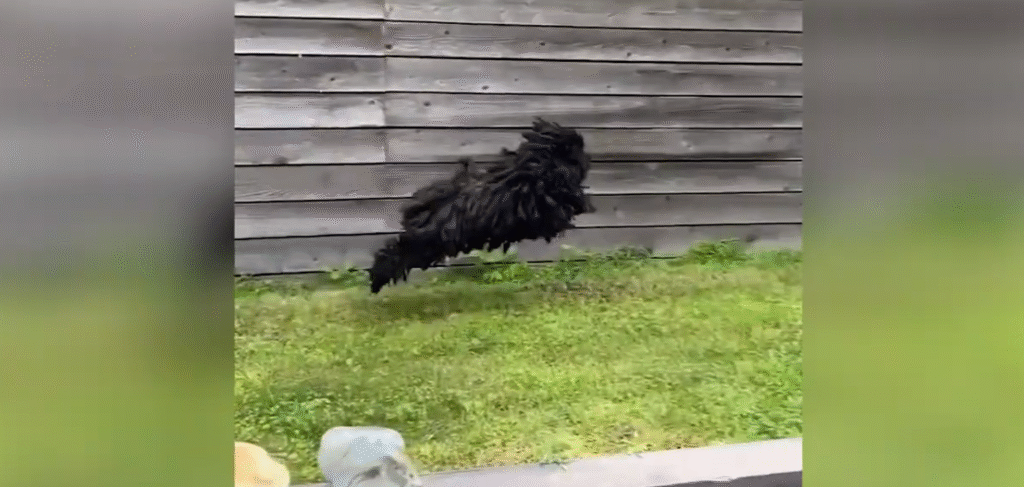Puli Hungarian Herding Dog – Quick Facts
| Feature | Details |
|---|---|
| Name | Puli (plural: Pulik) |
| Origin | Hungary |
| Nickname | Mop Dog, Hungarian Water Dog |
| Size | Small to Medium (16–17 inches, 23–35 pounds) |
| Coat Style | Naturally corded, wooly coat that resembles dreadlocks |
| Common Colors | Black, white, gray, and cream |
| Lifespan | Typically 10–15 years |
| Temperament | Protective, playful, independent, energetic |
| Exercise Needs | High – thrives on movement and mental stimulation |
| Famous Owners | Mark Zuckerberg, Harlan Ellison, T.C. Boyle |
| Grooming Requirement | High for corded coats; manageable if clipped |
| Official Reference | www.akc.org/dog-breeds/puli/ |

The Puli is frequently confused for a floor mop on legs, but once you know its background and capabilities, it’s anything but funny. The Puli were trained to survive as well as herd after being brought to Hungary by the Magyars as early as the ninth century. With its dreadlock-like coat, which is both practical and eye-catching, this dog has developed into one of the most aesthetically pleasing and nimble herders still in use today.
Their mission has gradually changed over the last century. Pulik, who were once valued by shepherds for their agility and herding instinct, have found new uses in both domestic settings and entertainment venues. Notably, tech entrepreneurs and creative thinkers now favor them. With his trademark loyalty and fluff, Mark Zuckerberg’s Puli, Beast, became an internet celebrity in his own right.
Despite its ornamental appearance, their coat is incredibly resilient. It naturally cords as the dog ages and is composed of a thick mixture of outer and undercoat. These cords form naturally rather than being groomed into place, despite what many people believe. By adulthood, the puli’s coat offers natural protection from thorny brush, insulation from cold, and a defense against bites, particularly when herding in rugged areas. Once, they were able to divert wolves and warn larger Komondors—another Hungarian breed used to protect livestock at night—thanks to their natural shield.
The Puli gained their status as a daytime guardian by moving at incredible speeds and blending in with sheep. The breed suffered a severe decline during the Soviet era as fencing and machinery took its place in agriculture. But its disposition—agility, loyalty, and keen intelligence—guaranteed its continued existence as a pet.
Enthusiasts have successfully introduced the Puli into contemporary homes throughout Europe, the United States, and even some regions of Asia through careful breeding and preservation efforts. Interestingly, in 1935, the U.S. Department of Agriculture began an experimental breeding program in which Pulik significantly outperformed other herding dogs in intelligence trials. Those early imports laid the groundwork for the American Puli population, even though the study was put on hold during World War II.
When it comes to dog ownership trends, Pulik is especially creative. They are both aesthetically pleasing and functional, acting as proactive protectors and drawing attention with their unique look. The Puli’s appearance developed for a purpose, in contrast to breeds created solely for aesthetics. In addition to being distinctive, the cords have historically been required. In a time when novelty pets are overbred, that authenticity adds value.
Living with a Puli, however, is not for the weak of heart. It takes time and care to keep their coat in good condition. Although there is little shedding, dirt and debris readily adhere to the cords. Although practical, some owners choose to shorten their Pulik’s length, a choice that breed purists occasionally criticize. The Puli’s vitality and intelligence, however, are remarkably unaffected even when clipped.
The Puli has influenced culture in ways beyond Instagram pages and dog shows. Ahbhu, the beloved Puli of author Harlan Ellison, appeared in several of his literary works. Ellison gave the dog emotional resonance, transforming a real-life pet into a symbol of defiance and loyalty. Known for his scathing tales and incisive prose, T.C. Boyle named one of his Puliks “Kutya,” which means dog in Hungarian, and wrote about him with obvious affection.
The Puli is more than just a breed; it is a symbol of tenacity, as evidenced by individual tales and widespread recognition. In the past, the wages for these dogs were equal to a year’s worth of work. These days, both artists and tech titans use them. The characteristics that characterize the Puli—a keen sense of intuition, a strong work ethic, and an almost comical charm—remain remarkably consistent despite such extreme environmental contrasts.
The breed’s ability to remember its origins is what makes its role so evident. Children, cats, and even delivery scooters are all naturally herded by Pulik, who were raised in urban apartments. They are always on guard, observing their surroundings and, if permitted, taking command. Generations of domestication have not erased that legacy of purpose.
The breed is incredibly adaptable and thrives in a variety of climates and terrains, but they require outdoor time to maintain their equilibrium. Exercise is necessary; it is not optional. Pulik may become agitated or reactive when understimulated, frequently releasing energy through obstinate behavior. However, with the right socialization and training, they develop into loving companions with a strong desire to please.
Pulik has begun to gain popularity in agility competitions in recent years, where their agility and quick footwork are evident. It’s visually stunning to watch one go through an obstacle course with cords flying behind them like tassels in a storm. Despite their woolly appearance, they move much more quickly than most people realize.
